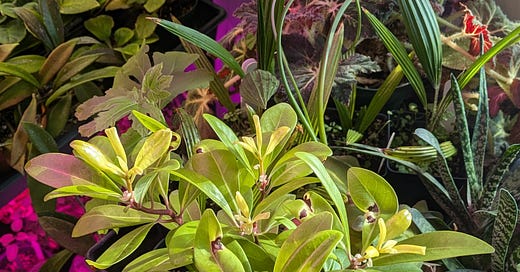Spicing up the garden with Florida anise
Illicium, whether you prefer to designate it as a member of the family Schizandraceae or consider it as the sole representative of its own family, the Illiciaceae, contains a number of species grown for their beauty, use in flavorings or as herbal medicines used to treat maladies such as flatulence.
The name comes from the Latin illicio, which doesn’t signify anything illegal or immoral about the genus; rather it means “allure”, for the spicy anise scent of some family members’ leaves, stems and seeds. Essential Illicium oils find their way into foods and alcoholic beverages, though certain species like the ornamental I. anisatum and I. floridanum have toxic properties.
Members of the Illiciaceae can be found in the Caribbean, the Far East and parts of the American southeast in the case of I. floridanum. They generally prefer moist habitats in partial to full shade and may tolerate more sun if there’s sufficient moisture.
Where it gets interesting for temperate zone gardeners is species and cultivar adaptability to winter cold - as far north as USDA zone 6a in some instances.
It was this characteristic that led me into temptation at last fall’s Plant Delights sale, when I acquired among other things Illicium ‘Florida Sunshine’, currently growing in a pot in a sunny window, destined for a prime garden spot next spring.
Illicium ‘Florida Sunshine’ is an I. parviflorum selection with chartreuse, anise/sassafras-scented leaves. Fall provides additional interest, as leaves become brighter yellow while stems turn red.. There are varying opinions on how much sun it can take, recommendations commonly ranging from partial to full shade, while Plant Delights notes that it does well in up to 6-8 hours of full sun. I. ‘Florida Sunshine’ prefers moist soil that is not allowed to dry out, and can reach 5-8 feet or more in height with equal width. Its cold hardiness depends on who you believe. Monrovia rates it as hardy only to USDA zone 8, while elsewhere it’s considered adaptable to zone 7a. Plant Delights rates ‘Florida Sunshine’ as suitable for zones 6a-9b - sounds good to me here in zone 7a, so I’m sticking with that. Significant pest problems have not been reported.
But what about flowers, you wonder? Some sources hardly mention flowers, so it takes a bit of detective work to find out that this shrub produces 1/2 inch pale yellow (or dark golden-yellow, again depending on who you believe) spring flowers that tend to blend in with the foliage.
I. ‘Florida Sunshine’ can be propagated by seed, stem cuttings or air layering. I’ll be taking cuttings some time this year, a typical precaution when growing a new plant whose cold hardiness is at all controversial.
‘Florida Sunshine’ might look appealing in the border partnered with purple-foliaged plants, like my (so far) perennial ‘Tropicanna Black’ cannas, Hibiscus acetosella (now being marketed under the name ‘Mahogany Splendor’) or Alternanthera ‘Purple Knight’.

If you want standout blooms from your Illicium, consider Illicium floridanum ‘Miss Scarlett’. It has similarly anise-scented, green leaves and is said to have cultural requirements similar to I. parviflorum ‘Florida Sunshine’, thriving in moist soil in partial to full shade. ‘Miss Scarlett’ is rated for zones 7a-10b.
The foliage of both of the above-described cultivars is toxic if ingested, so no nibbling.




